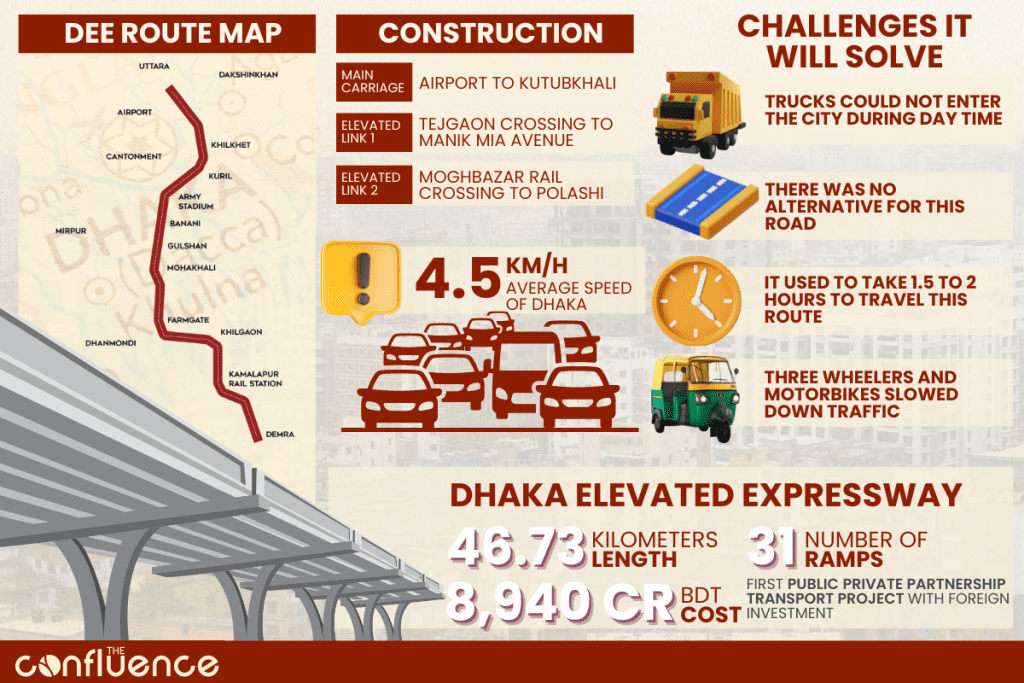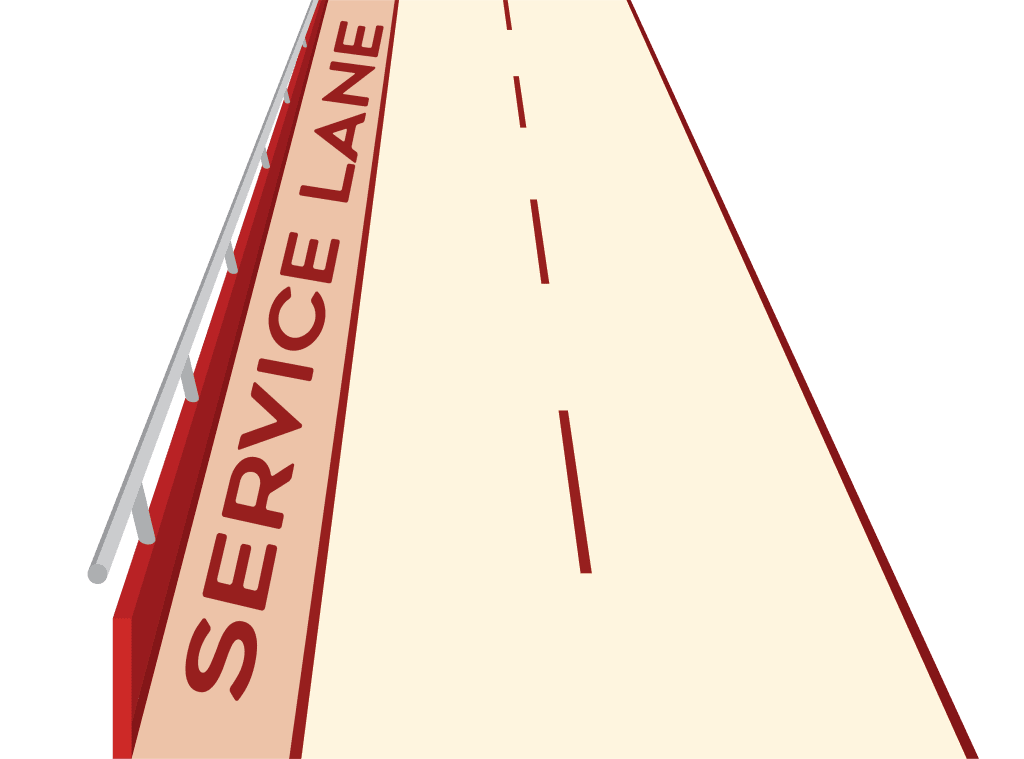Dhaka, the capital of Bangladesh, is the seventh most densely populated city in the world with a population of 22.4 million in Greater Dhaka. Over the years, Dhaka’s economy has been showcasing signs of growth as the city adds more high-rises to its skyline, more cars on its streets and more disposable incomes for its residents to invest and spend in new avenues
However, the residents of Dhaka have grown an extraordinary level of traffic tolerance, experiencing congestion on a regular basis that can bring the metropolis to a standstill. On average, a return trip by car across the city can take four-five hours. The average traffic speed is 4.5 km/h on the roads of this megacity. Private cars compete for space on the road with buses, motorcycles, scooters, CNGs, rickshaws, and auto-rickshaws. Commuting from one part to another part of the city has become a time-consuming, and sometimes expensive task. Traffic jams waste around 3.2 million work hours each day for which residents have to dedicate at least extra 2 to 3 hours for their commuting purposes.
To address such challenges of Dhaka’s traffic congestion and accommodate a growing mobile population, the Government of Bangladesh has undertaken several infrastructure megaprojects such as the Dhaka Metro Rail, Dhaka Elevated Expressway (DEE) to build an entire urban transportation system.
This article dives deeper into Bangladesh’s first Public-Private Partnership (PPP) transport megaproject, Dhaka Elevated Expressway (DEE) which aims to ease traffic congestion and facilitate a modern commute system in Dhaka.

Highlights of the DEE
The Dhaka Elevated Expressway will commence at Hazrat Shahjalal International Airport and end at Dhaka-Chittagong highway near Kutubkhali, after the completion of the entire project. The elevated expressway is 46.73 km long including the 19.73 km long main flyover (Elevated 4 Lane Dual Carriageways), 31 km ramps and elevated links. In addition to the main four-lane dual carriageway and 2 suspended termini at its ends, the expressway is equipped with 5 interchanges, 2 elevated links, 31 entry and exit ramps (consisting of 15 on-ramps and 16 off-ramps) with a total length of 27 kilometers (1-Lane Carriageway), a set of 8 toll plazas and 43 Toll Booths. The expressway’s maximum traffic speed limit will be 60 km per hour.
The total project cost is around BDT 8,940 crore. The Government of Bangladesh (GoB) will provide the viability gap funding which is around BDT 2,413 crore.
BDT
3000
CR
Project Cost
30
km
Total Length
Main Carriageway/Line
The alignment of the main carriageway will be as follows:
Hazrat Shahjalal International Airport – Kuril – Banani – Mohakhali – Tejgaon-Satrasta – Moghbazar Rail Corridor – Khilgaon – Kamalapur – Sayedabad – Jatrabari – Kutubkhali (near Dhaka-Chittagong Highway)
Elevated Link 1
The Elevated Link 1 is about 1.8 km long and will connect the DEE at Tejagon Crossing to Holy Cross College – Farmgate – Manik Mia Avenue.
Elevated Link 2
The Elevated Link 2 is about 3.5 km long and will connect the DEE (close to Moghbazar Rail Crossing) to Hotel Sonargaon (back side) – Hatirpool – Katabon – Polashi.
Toll Plazas
A total of 8 toll plazas will be constructed which will be composed of toll canopy with toll booths, toll surveillance building and weigh station.
The toll plaza at the entrance of the expressway features 6 booths, including 2 equipped with an electronic toll collection system. Each toll plaza regardless of its location will have a minimum of four lanes to ensure efficient traffic movement on the expressway.

Commuters will be required to pay tolls to use the expressway. The toll rates for the Hazrat Shahjalal International Airport-Farmgate section varies from BDT 80 to BDT 400. For vehicles falling under category 1, including cars, taxis, jeeps, sports utility vehicles, microbuses (under 16 seats), and light trucks (weighing less than 3 tonnes), the toll for crossing the airport-Farmgate section from any point is BDT 80. Vehicles classified as medium trucks (up to six wheels), fall under category 2, with a toll rate of BDT 320 for crossing the route from any point. In category 3, the toll for trucks (more than six wheels) is set at BDT 400 for crossing the route from any point. Under category 4, any bus (16 seated or above) will be charged a toll of BDT 160 for crossing the route from any point.
Service Lane
The expressway carriage has service lanes running parallelly to the main road on both sides. The service lanes will allow swift passage to vehicles after any incidents.

Central Control Building (CCB)
A multi-storey Central Control Building (CCB) will manage the toll collections and monitor traffic via CCTV cameras installed across the expressway. The presence of 24/7 surveillance also means if there is any occurrence including criminal activities on the expressway, the relevant authorities can immediately take steps to address such issues.
An Operation and Maintenance Company has been formed for the operation and maintenance of DEE. This company will be responsible for round-the-clock monitoring of DEE and resolving any issues that may arise on the expressway.
Weighing Bridge
Weigh bridges are used to measure the weight of the vehicles. The DEE will contain weigh bridges which will be set up at entry ramps. The weighing bridges will alert drivers of overloaded vehicles (according to guidelines).

Additionally, electronic signs will notify drivers about congestion or lane closures.
To ensure international quality standards, the road surface is being designed to meet the American Association of State Highway and Transportation Officials load and resistance factor design AASHTO LRFD Construction Specification – 3rd Edition 2010 for asphalt type and quality.
Challenges DEE Will Solve
1. Reduction in Traffic Congestion and Ease of Travel
The elevated expressway is set to establish an alternative route throughout the city. The DEE will be instrumental in connecting various factories and the expanding international airport in the northern part of the city, and serving the main port of Chittagong in the southern region. The DEE will significantly reduce travel times, converting journeys that previously took hours into mere minutes. It will take only 10 minutes to travel the 11 km distance from the airport to Farmgate.
Once both the Dhaka Elevated Expressway and the Dhaka-Ashulia Expressway become operational, individuals traveling from the northern, western, and southwestern regions of the country will have the ability to traverse from one side of the city to the other without even entering the city streets.
Furthermore, the expressway’s unique Y-shaped concrete piers will contribute to the city’s architectural aesthetics long with inverted U-shaped pillars for leaving room for wide roads and railway. With its spans reaching up to 40 meters, the 9.4-meter-wide dual carriageway will take traffic away from the streets below.

2. Facilitating Businesses
Trucks and lorries cannot enter Dhaka within daytime, so they have to spend a significant time standing still near the entrances of Dhaka, waiting for 10 pm to tick on the clock so that they can reach Karwan Bazar or other parts of the city. This puts a strain on factory output and jeopardizes businesses. When the expressway is operational, trucks carrying goods can enter 24/7 without interrupting the city’s daytime traffic. Since the 27km of ramps will be connected to the existing road network, Dhaka’s medium-sized business owners will also be hugely benefited by significantly reducing their travel time. The expressway will massively benefit businesses in Dhaka EPZ, Gazipur, and Savar areas truck and lorries from these areas will be able to travel during the day.
Thus, the Dhaka Elevated Expressway will redefine the commuting experience across Dhaka and enable businesses to flourish as the DEE solves the transportation challenges in the country’s capital.
Photo: Adnan Adid/ UNB
4 comments
[…] the metropolis to a standstill. The average speed of traffic on the roads of this megacity is 4.5 km/h. Each day, traffic jams waste 3.2 million work hours, coercing the residents of the city to add an […]
[…] the metropolis to a standstill. The average speed of traffic on the roads of this megacity is 4.5 km/h. Each day, traffic jams waste 3.2 million work hours, coercing the residents of the city to add an […]
[…] Framework Aims to Achieve How Dhaka Metro Rail Is Transforming Bangladesh’s Urban… Dhaka Elevated Expressway: The Essentials Questioning the Rationale of Imposing Age Limit for… Karnaphuli Tunnel : The Case for […]
[…] Framework Aims to Achieve How Dhaka Metro Rail Is Transforming Bangladesh’s Urban… Dhaka Elevated Expressway: The Essentials Karnaphuli Tunnel : The Case for Bangladesh’s First… Questioning the Rationale of […]